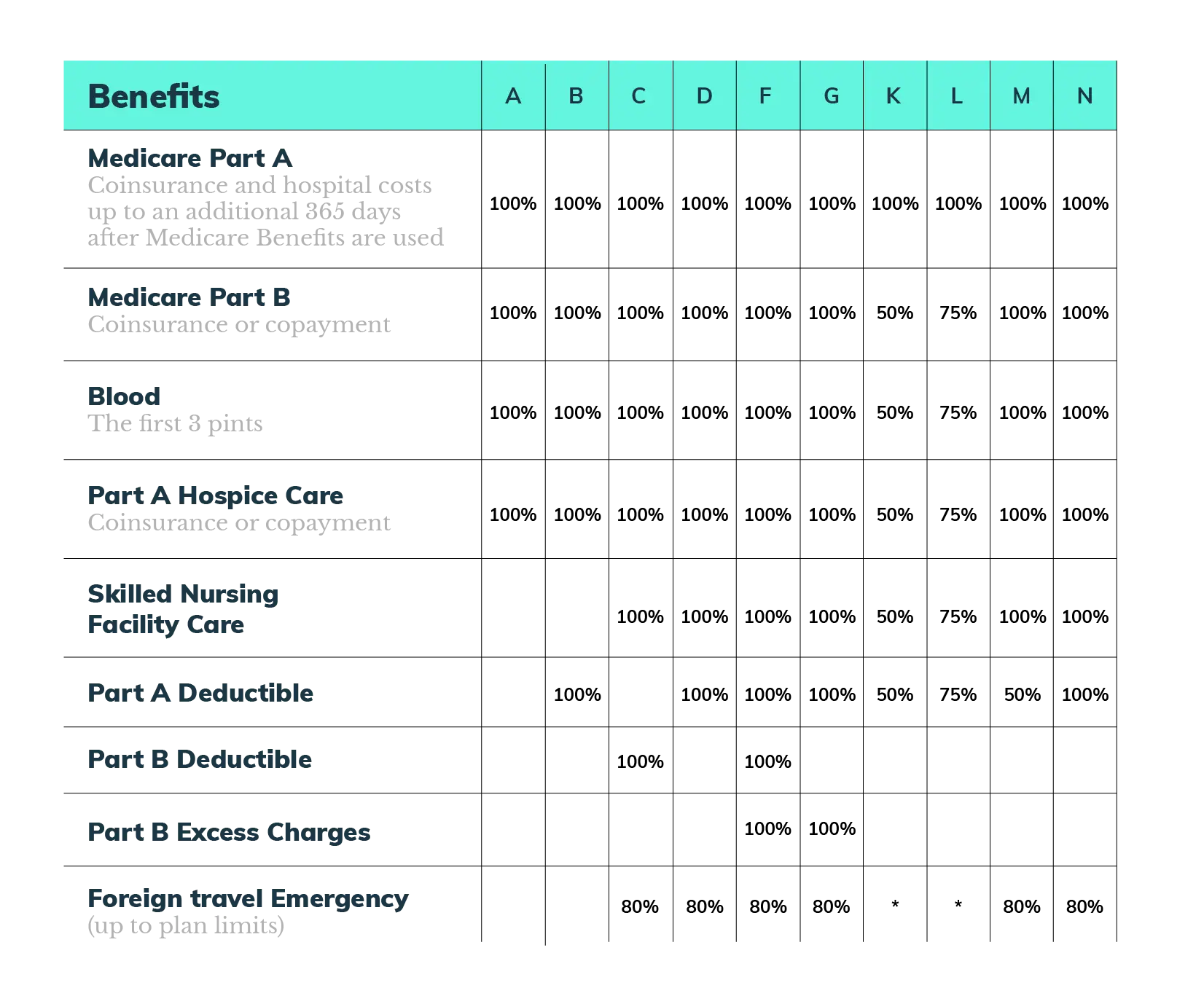The Ultimate Guide to Medicare Supplement Plans in Pennsylvania
Read on to learn more about how Medicare beneficiaries in Pennsylvania manage their out-of-pocket costs for Medicare
Our content follows strict guidelines for editorial accuracy and integrity. Learn about our and how we make money.
If you need to be hospitalized for an extended period of time or require expensive medical equipment, your medical costs can add up quickly.
Unfortunately, the federal Medicare program won't cover all your medical costs. This is why most Americans use private health cover, such as Medicare Advantage or Medicare Supplement Insurance, to help cover expenses.
This article will look at Medicare Supplement Insurance in Pennsylvania, when the best time is to apply, and how much you can expect to pay for different plans.
Let’s Recap: What Are Medicare Supplement Plans?
A Medicare Supplement Plan (also known as a Medigap policy) is a type of health insurance that pays for out-of-pocket costs that Medicare does not cover.
If you have Original Medicare but aren’t enrolled in a Medicare Advantage Plan (Part C) or Prescription Drug Plan (Part D), you can apply for Medicare Supplement Insurance.
There are ten standardized Medicare Supplement Insurance plans in Pennsylvania. Each plan is identified by a letter: A, B, C, D, F, G, K, L, M, or N.
Plan F and Plan G are also available in two high-deductible versions, which we’ll cover later in the article.
These Medicare plans are identical across 47 states, so if you join a policy in Pennsylvania you will receive the same Medicare coverage as someone in Louisiana or Florida.
However, Wisconsin, Minnesota, and Massachusetts each have their own Medicare Supplement Insurance Plans with different names and benefits.
Terms You Need to Know:
Deductible: This refers to the set amount you pay for health care services before Medicare plans begin to pay.
Coinsurance: The percentage of costs you pay for medical services, tests, and items.
Copayment: A set rate you must pay for doctor visits, hospital stays and prescription drugs.
Out-of-pocket expenses: This term refers to costs that are not covered by Medicare plans which you must pay for yourself. For example, a fee for a visit to the dentist.
The amount of coverage you receive will depend on which Medicare Supplement Insurance Plan you choose.
Each plan will generally cover these kinds of expenses:
Your deductibles: The amount you need to pay before your insurance begins to cover medical expenses.
Coinsurance: A part of the medical costs you must pay (for Medicare Part B this is 20% of the costs, and for Part A this is a daily rate).
Other out-of-pocket costs: This can include blood transfusions and foreign emergency cover, which Medicare doesn’t pay for.
If you would like to take a more detailed look at Medicare Supplement Plans and what they offer, be sure to read this article.
Key Takeaways:
Medicare Supplement Insurance Plans help with expenses that Original Medicare Part A and B don’t cover.
There are ten different Medicare Supplement Insurance Plans you can choose from in Pennsylvania. They can be identified by a letter: A, B, C, D, F, G, K, L, M and N.
If you already have Medicaid or a Medicare Advantage Plan, an insurance company cannot sell you a Medicare Supplement Insurance Plan.

(Source: Pexels)
When Is the Best Time to Enroll in a Medicare Supplement Plan in Pennsylvania?
Although you can get Medicare Supplement Insurance at any time of the year in Pennsylvania, the recommended time to do it is during your Open Enrollment Period.
This is because you are likely to get better Medicare premiums, have more options available to you, and will not need to go through medical underwriting.
What Is Medical Underwriting?
Medical underwriting is a review of your medical history. Health insurance companies perform medical underwriting to decide:
Whether they will accept people for certain plans.
How much they will have to pay to join.
How long people will have to wait before their medical expenses are covered.
When Does the Open Enrollment Period (OEP) Begin?
In general, this window only happens once in your life when you reach the age of 65 (unless you collect Social Security Disability Income).
Your OEP will last six months, starting on the first day of the month that your Medicare Part B coverage begins.
For example, if you enroll in Medicare Part B and your coverage begins on May 1st, your Open Enrollment Period will end on October 1st.
A lot of people get the Open Enrollment Period confused with their Initial Enrollment Period. Here’s a table to outline how they are different:
| Initial Enrollment Period | Open Enrollment Period | |
|---|---|---|
| What is it for? | If you want to join the Medicare program. | If you want to join a Medicare Supplement Plan. |
| When does it start? | Three months before your 65th birthday month. | The first day of the month that your Part B cover begins. |
| How long does it last? | 7 months | 6 months |
The OEP is one of many enrollment periods that you should be aware of. Check out this table to see what others there are:
| Enrollment Period | Description |
|---|---|
| Open Enrollment Period | This six-month period begins on the first day of the month when you are 65 or older and enrolled in Medicare Part B. This date will be different for everyone and depends on the month that you sign up. |
| Fall Medicare Open Enrollment Period | During this window, you can change your Medicare Supplement Insurance Plan without losing any medical coverage. This window takes place every year from October 15th to December 7th. |
| Initial Enrollment Period | This is your first chance to sign up for Medicare once you are eligible and begins three months before your 65th birthday. During the IEP, you can sign up for Medicare Parts A and B, Medicare Advantage Plans or a Part D Prescription Drug Plan. |
| General Enrollment Period | From January 1st to March 31st, you can sign up for Medicare Parts A and B, as well as Medicare Advantage Plans if you missed the deadline. |
| Special Enrollment Period | This period refers to specific situations where you can enroll outside the regular enrollment periods (for example, if you move states or your health care coverage under an employer ends). The dates for the Special Enrollment Period differ from person to person. |
For more information, read our guide to Medicare Open Enrollment Period 2022.
What Are the Most Popular Medicare Supplement Plans?
In Pennsylvania, there are 12 Medicare Supplement Insurance Plans that you can choose from.
Plan A, B, C, D, F, G, K, L, M, N, and high-deductible versions of Plan F and G.
What are high-deductible Medicare Supplement plans?
High-deductible plans have a low monthly premium but a very high deductible (the amount of money you need to pay before your insurance covers your medical expenses). For example, Plan F had a $2320 deductible charge in 2022.
The table below summarizes the basic benefits that each plan covers.
Where you see a percentage, the Medicare Supplement Plan covers that percentage of the benefit and you must pay the rest. For example, if it says 100% it means the plan fully covers your expenses.

Some of these Medicare plans have important details you should be aware of. For example:
Plans K and L have out-of-pocket limits of $6,220 and $3,110. Once you have paid these amounts and the Part B deductible of $233, the plan will pay 100% of your covered services for the rest of the year.
Plans C and F will not be available to people who are newly eligible for Medicare Insurance Supplement Plans on or after 1 January 2020.
Plan N will pay 100% of the Part B coinsurance. However, you will have to pay up to $20 for doctor visits and $50 for emergency room visits.
A Recap of Key Terms:
Deductible: This refers to the set amount you pay for health care services before your insurance begins to pay.
Coinsurance: The percentage of costs you pay after your deductible has been met.
Copayment: A set rate you must pay for doctor visits, hospital stays and prescriptions.
Let’s Take a Look at the Most Popular Supplement Plans in Pennsylvania
Of the Medicare Insurance Supplement Plans available in Pennsylvania, research shows that Plans F, G, and N were the most popular in 2019.
Medicare Supplement Plan Enrollment Numbers (2019)
Plan F: 265,394
Plan G: 146,399
Plan N: 102,961
Medicare Insurance Supplement Plan F
In Pennsylvania, Plan F is popular because it covers nearly all Medicare Part A and B expenses, including deductibles and coinsurance.
Plan F is available in both a standard and a high-deductible version. Both types of Supplement Plans provide complete coverage, although their monthly premiums are often higher than other Medicare Insurance Supplement Plans.
Unfortunately, Medicare no longer allows supplemental insurance plans that cover the Medicare Part B deductible. This means that Plan F is not available to people who became Medicare-eligible after January 1, 2020.
Remember:
Medicare Part B insurance covers outpatient services like specialist consultations, preventative services like screenings, and certain durable medical equipment costs like walkers or wheelchairs.
If you were born after 1955 and don’t collect Social Security Disability Insurance or Railroad Retirement Board Disability Benefits, you probably won’t be able to purchase this plan.
However, if you were eligible for Medicare before 2020 you might be able to buy Plan F in Pennsylvania.
If you’d like to find out more about the eligibility requirements of Medicare Insurance Supplement Plan F and how much it could cost you, read this article.

(Source: Pexels)
Medicare Insurance Supplement Plan G
Plan G is another popular option for lowering Medicare out-of-pocket expenses. Plan G, like Plan F, has a $2,370 high-deductible option, although it is only available to people who turned 65 before January 1, 2020.
Plan F differs from Plan G because it does not cover the Medicare Part B deductible.
Medicare Part B has an annual deductible of $233 and an average monthly premium of $170.10. Your monthly premium might be different based on your income; read this article on Medicare Part B to learn more.
Look at this article for more information on what Medicare Plan G covers and how much you may expect to pay in monthly premiums.
Medicare Insurance Supplement Plan N
Plan N also covers the majority of Medicare expenses, with the exception of the Part B deductible and excess charges.
This means that you must pay the $233 annual deductible fee before Medicare starts to pay and you can use your Plan N benefits.
Excess charges are fees for services, tests, and items that are higher than the Medicare-approved levels.
For example, if an operation costs $1,000 more than the Medicare-approved amount, your Medicare Plan N will not pay the difference.
- You will have to pay 20% coinsurance for the total amount (Medicare covers 80%).
- You will need to pay the difference ($1000) out of your own pocket.
Our article on Medicare Plan N covers everything you need to know about this Supplement Plan.
If you are still unsure or have questions about Pennsylvania Medicare Insurance Supplement Plans, please contact one of PolicyScout's knowledgeable Medicare experts.
How Much Do Medicare Supplement Plans Cost in Pennsylvania?
Although the benefits of Medicare Supplement Insurance Plans are standardized, monthly premiums can vary, and health insurance companies can set their own pricing for coverage.
Remember that your location, health, and lifestyle will be considered when a health insurance company sets your rate.
For example, a health insurance firm may:
Want to primarily offer Medicare Supplement Insurance to non-tobacco users.
Medicare Supplement Insurance plans are only available in a few counties.
Charge higher fees to ensure all their members have proper coverage.
In general, there are three ways that an insurance company can set their premiums.
These are:
Community-rated: This premium is not based on your age. This means that the same monthly premium is charged to everyone. However, the price will change according to inflation.
Issue-age rated: This premium is based on the age you are when you buy the policy. Therefore, the premium is lower for Medicare beneficiaries who buy it at a younger age and won’t change as they get older.
Attained-age rated: This premium is based on current age and will increase as medicare beneficiaries get older. Although these premiums might be the least expensive at first, they will eventually become the most costly and affected by inflation.
Let’s look at an example to give you an idea of how much Medicare Supplement Insurance Plans in Pennsylvania cost.
Meet Mark
Mark is a 65-year-old man living in Harrisburg, Pennsylvania. His postal code is 17113, and he doesn’t use tobacco products. He is trying to decide between Medicare Supplement Insurance Plans C, G (high-deductible), and N. Let’s take a look at his options:

(Source: Pexels)
Plan CMark can buy Plan C because he turned 65 in 2019. If he turned 65 after January 1st, 2020, he wouldn’t be allowed to purchase Plan C coverage.
In Harrisburg, Pennsylvania, Medicare Supplement Plan C monthly premiums range between $136 and $330. But this does not include the $170.10 standard monthly premium for Medicare Part B.
Example - Mark’s Monthly Expenses for Plan C
Plan C Monthly Premium: $136 - $330
Part B Monthly Premium: $170.10
Total Monthly Costs: $306.10 - $500.10
He will also not have any copayments, coinsurance, or Part A and B deductibles, but he will have to pay the difference if he uses a medical provider that charges more than Medicare-approved amounts.
If he needs to go to the hospital or requires care in a skilled nursing facility, he won’t have to pay any costs.
If he needs medical assistance while traveling overseas he will have to cover the first $250, then his plan will pay 80% of the cost.
Plan C Benefits:
✅ Skilled Nursing Facility
✅ Part A Deductible
✅ Part B Deductible
❌ Part B Excess Charges
✅ Foreign Travel Emergency Cover (80%)
Plan G (high deductible)
High-deductible plans are for people who would like to save money on monthly fees but still have access to supplemental insurance if they need it.
In Pennsylvania, Medicare Plan G (high-deductible) monthly premiums are between $40 and $59.
With the high-deductible version of Plan G, Mark won’t have any copayments or coinsurance costs, but he will still have to pay the Medicare Part B premium ($170.10) each month.
Example - Mark’s monthly expenses for Plan G (high deductible)
Part B Monthly Premium: $170.10
Medicare Plan G Monthly Premium: $40 - $59
Total Monthly costs: $210.10 - $229.10
He will have foreign emergency travel benefits up to $50,000, and he will also get the first 100 days of treatment at a skilled nursing facility covered.
He will also have to pay a $2,370 deductible for the year to get full coverage for approved Part B and Part A procedures.
For example, if Mark is hospitalized for 90 days and only has Original Medicare, here’s what his medical expenses might look like:
Part A expenses: Original Medicare vs Plan G
| Original Medicare | Original Medicare with Plan G coverage |
|---|---|
| Part A Deductible (2021): $1,556 | Mark will have to pay $2,370. |
| Day 1-60: $0 | His supplemental insurance will then cover all of the approved costs. |
| Day 61-90: $389 x 30 days ($11,670) | |
| Total Costs: $13 226 | Total Costs: $2,370 |
Plan G (High-deductible) Benefits:
✅ Skilled Nursing Facility (100-day limit)
✅ Part A Deductible
❌ Part B Deductible
✅ Part B Excess Charges
✅ Foreign Travel Emergency
Plan N
If Mark chooses Medicare Supplement Plan N, he can expect a monthly premium of between $70 and $400. Like the other plans we’ve discussed, this does not include the $170.10 standard Part B deductible.
Example - Mark’s monthly expenses for Plan N
Part B Monthly Premium: $170.10
Medicare Plan N Monthly Premium: $70 - $400
Total Monthly costs: $240.10 - $570.10
On Plan N, when Mark visits the doctor or the emergency room, he will have copayments of $20 and $50.
He will also have to pay the $233 Medicare Part B deductible and can expect to pay excess charges for Part B expenses.
Medicare Plan N also includes foreign travel emergency benefits and coverage for treatment in a skilled nursing facility.
Plan N Benefits:
✅ Skilled Nursing Facility
✅ Part A Deductible
❌ Part B Deductible
❌ Part B Excess Charges
✅ Foreign Travel Emergency
The table below summarizes the costs and benefits of each of the Medicare Supplement Insurance Plans Mark is interested in:
| Plan C | Plan G (high-deductible) | Plan N | |
|---|---|---|---|
| Monthly premiums | $102 to $311. | $40 to $59. | $70 to $400. |
| Medicare Part B premium cover | No | No | No |
| Copayments | None for approved Part B (outpatient) services. | None for approved Part B (outpatient) services. | $20 for visits to the doctor.$50 for visits to the hospital. |
| Deductible costs | $233 (Part B) | $233 (Part B) | $233 (Part B) |
| Foreign Travel Emergency Cover | Yes | Yes | Yes |
| Part B Excess Charges | Not covered | Covered | Not covered |
As you can see, Medicare Supplement Plans differ greatly in terms of benefits and costs. Before you sign up for a plan, we recommend that you do your research.
When weighing up your options, consider the health insurance company's history, reviews, area of coverage, and prices. It's also a good idea to shop around for Medicare plans or providers.

(Source: Pexels)
Where Can I Find Out More about Medicare and Supplement Insurance?
Visit our Medicare Hub, where you can find articles on the federal Medicare program and Medicare coverage options. We also cover Medicare eligibility, Medicare Advantage plans, Part D plans, and Original Medicare.
If you want advice about Supplemental Insurance or Medicare Advantage plans in your area, contact a licensed insurance agent at 1-888-912-2132 or email us at Help@PolicyScout.com.